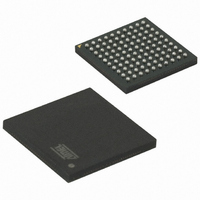ATSAM3U4CA-CU Atmel, ATSAM3U4CA-CU Datasheet - Page 599

ATSAM3U4CA-CU
Manufacturer Part Number
ATSAM3U4CA-CU
Description
IC MCU 32BIT 256KB FLSH 100TFBGA
Manufacturer
Atmel
Series
SAM3Ur
Specifications of ATSAM3U4CA-CU
Core Processor
ARM® Cortex-M3™
Core Size
32-Bit
Speed
96MHz
Connectivity
EBI/EMI, I²C, MMC, SPI, SSC, UART/USART, USB
Peripherals
Brown-out Detect/Reset, DMA, I²S, POR, PWM, WDT
Number Of I /o
57
Program Memory Size
256KB (256K x 8)
Program Memory Type
FLASH
Ram Size
52K x 8
Voltage - Supply (vcc/vdd)
1.65 V ~ 1.95 V
Data Converters
A/D 4x10b, 4x12b
Oscillator Type
Internal
Operating Temperature
-40°C ~ 85°C
Package / Case
100-TFBGA
Processor Series
ATSAM3x
Core
ARM Cortex M3
Data Bus Width
32 bit
Data Ram Size
52 KB
Interface Type
3xUSART, TWI, 4xSPI, Bus
Maximum Clock Frequency
96 MHz
Number Of Programmable I/os
57
Number Of Timers
8
Operating Supply Voltage
1.62 V to 3.6 V
Maximum Operating Temperature
+ 85 C
Mounting Style
SMD/SMT
3rd Party Development Tools
JTRACE-CM3, MDK-ARM, RL-ARM, ULINK2
Development Tools By Supplier
ATSAM3U-EK
Minimum Operating Temperature
- 40 C
Lead Free Status / RoHS Status
Lead free / RoHS Compliant
Eeprom Size
-
Lead Free Status / Rohs Status
Lead free / RoHS Compliant
Available stocks
Company
Part Number
Manufacturer
Quantity
Price
Part Number:
ATSAM3U4CA-CU
Manufacturer:
ATMEL/爱特梅尔
Quantity:
20 000
- Current page: 599 of 1171
- Download datasheet (25Mb)
Figure 32-9. Chip Select Decoding Application Block Diagram: Single Master/Multiple Slave Implementation
32.7.3.8
32.7.3.9
6430D–ATARM–25-Mar-11
6430D–ATARM–25-Mar-11
SPI Master
Peripheral Deselection without DMAC
Peripheral Deselection with DMAC
NPCS0
NPCS1
NPCS2
NPCS3
SPCK
MISO
MOSI
During a transfer of more than one data on a Chip Select without the DMAC, the SPI_TDR is
loaded by the processor, the flag TDRE rises as soon as the content of the SPI_TDR is trans-
ferred into the internal shift register. When this flag is detected high, the SPI_TDR can be
reloaded. If this reload by the processor occurs before the end of the current transfer and if the
next transfer is performed on the same chip select as the current transfer, the Chip Select is not
de-asserted between the two transfers. But depending on the application software handling the
SPI status register flags (by interrupt or polling method) or servicing other interrupts or other
tasks, the processor may not reload the SPI_TDR in time to keep the chip select active (low). A
null Delay Between Consecutive Transfer (DLYBCT) value in the SPI_CSR register, will give
even less time for the processor to reload the SPI_TDR. With some SPI slave peripherals,
requiring the chip select line to remain active (low) during a full set of transfers might lead to
communication errors.
To facilitate interfacing with such devices, the Chip Select Register [CSR0...CSR3] can be pro-
grammed with the CSAAT bit (Chip Select Active After Transfer) at 1. This allows the chip select
lines to remain in their current state (low = active) until transfer to another chip select is required.
Even if the SPI_TDR is not reloaded the chip select will remain active. To have the chip select
line to raise at the end of the transfer the Last transfer Bit (LASTXFER) in the SPI_MR register
must be set at 1 before writing the last data to transmit into the SPI_TDR.
When the Direct Memory Access Controller is used, the chip select line will remain low during
the whole transfer since the TDRE flag is managed by the DMAC itself. The reloading of the
SPI_TDR by the DMAC is done as soon as TDRE flag is set to one. In this case the use of
CSAAT bit might not be needed. However, it may happen that when other DMAC channels con-
1-of-n Decoder/Demultiplexer
SPCK
Slave 0
MISO MOSI
NSS
SPCK MISO MOSI
Slave 1
NSS
SAM3U Series
SAM3U Series
SPCK MISO MOSI
Slave 14
NSS
599
599
Related parts for ATSAM3U4CA-CU
Image
Part Number
Description
Manufacturer
Datasheet
Request
R

Part Number:
Description:
KIT EVAL FOR AT91SAM3U CORTEX
Manufacturer:
Atmel
Datasheet:

Part Number:
Description:
AT91 ARM Thumb-based Microcontrollers
Manufacturer:
ATMEL [ATMEL Corporation]
Datasheet:

Part Number:
Description:
DEV KIT FOR AVR/AVR32
Manufacturer:
Atmel
Datasheet:

Part Number:
Description:
INTERVAL AND WIPE/WASH WIPER CONTROL IC WITH DELAY
Manufacturer:
ATMEL Corporation
Datasheet:

Part Number:
Description:
Low-Voltage Voice-Switched IC for Hands-Free Operation
Manufacturer:
ATMEL Corporation
Datasheet:

Part Number:
Description:
MONOLITHIC INTEGRATED FEATUREPHONE CIRCUIT
Manufacturer:
ATMEL Corporation
Datasheet:

Part Number:
Description:
AM-FM Receiver IC U4255BM-M
Manufacturer:
ATMEL Corporation
Datasheet:

Part Number:
Description:
Monolithic Integrated Feature Phone Circuit
Manufacturer:
ATMEL Corporation
Datasheet:

Part Number:
Description:
Multistandard Video-IF and Quasi Parallel Sound Processing
Manufacturer:
ATMEL Corporation
Datasheet:

Part Number:
Description:
High-performance EE PLD
Manufacturer:
ATMEL Corporation
Datasheet:

Part Number:
Description:
8-bit Flash Microcontroller
Manufacturer:
ATMEL Corporation
Datasheet:

Part Number:
Description:
2-Wire Serial EEPROM
Manufacturer:
ATMEL Corporation
Datasheet:











